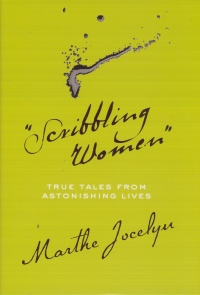| ________________
CM . . .
. Volume XVII Number 36. . . .May 20, 2011 
 |
Scribbling Women: True Tales from Astonishing Lives.
Marthe Jocelyn.
Toronto, ON: Tundra Books, 2011.
208 pp., hardcover & e-book, $21.99 (hc.), $21.99 (e-book).
ISBN 978-0-88776-952-8 (hc.), ISBN 978-1-77049-230-1 (e-book).
Subject Headings:
Literature-Women authors.
Women authors-Biography.
Grades 5-8 / Ages 10-13.
Review by Ann Ketcheson.
**** /4
|
| |
|

excerpt:
Most of “my” women would be surprised to find themselves inside a book. They might not be surprised, however, to know that the title began as a sneer, made by a famous male writer named Nathaniel Hawthorne in a letter to his publisher in 1855, where he complained about what he considered the irritating fad of “scribbling women”.
Everyone has trials and sorrows, and moments of boredom or immense delight. But these scribbling women wrote it down, passed it along, told us they were here, and took the time to illuminate their worlds.
For us, their grateful readers.
Do you keep a journal, write letters or perhaps enjoy making lists? Can you imagine what would happen if what you wrote was found at some point in the distant future? In Scribbling Women, Marthe Jocelyn looks at the lives of 11 very different women whose ‘scribbles’ in the form of diaries, letters, poems, and, in some cases, published books have fortunately been preserved so that we have a first-hand glimpse of the times in which they lived, the places they visited, the adventures and experiences they faced. The women are all completely different, and so readers find themselves in such diverse environments as the Japanese court of the 10th century, a whaling ship in stormy seas, Australia with the convicts sent to settle there, a field hospital during the war in Vietnam. These women all faced hardships and obstacles, but no two stories are alike. The threads that bind them together include their bravery, their sense of adventure, their stubbornness, and their willingness to follow their dreams even when those around them disapproved.
Jocelyn keeps her audience in mind throughout the book. No biography exceeds twenty pages and most are shorter. Words or expressions which might be difficult for young readers are briefly explained. For example, “The author quickly introduced the seventeen-year-old heroine of the story, who is Mr. Salteena’s ward (“Keeping a ward” was a frequent practice in upper-middle-class Victorian England. It meant being responsible for a young person’s education and introduction to society).” In some cases, Jocelyn also explains how attitudes and customs have changed, and so something which might seem condescending or biased when read with modern eyes was simply the normal expression for the times. For example, before quoting Margaret Catchpole’s description of aboriginals in Australia, Jocelyn comments, “Here is Margaret’s description (showing the prejudice typical in those days) of the new race of humans she was encountering.”
Jocelyn also reminds her young readers of the significance of time when letters, for example, travelled by sea and might take months to reach their destination. She mentions how accustomed we now are to almost instantaneous news broadcasts from anywhere in the world and the fast communication we expect when we use telephones or the internet. Thusly, Jocelyn helps her audience appreciate not only the physical difficulties encountered by many of these women but also the problems they would have had in relaying their experiences to family and friends.
Scribbling Women merely skims the surface in each biography, giving readers only the essence of each woman’s life and writing. As such, it serves only as an introduction, something to pique one’s curiosity. For those wanting more information, there is a bibliography as well as an extensive set of notes included at the end of the book which would aid in further research. The book is a springboard for research into these or other authors or perhaps into some of the subjects mentioned, such as life in the Arctic or the early treatment of the mentally disabled.
Jocelyn may also inspire her readers simply to write, to keep a journal of their thoughts and ideas or a diary of daily events. One of the most inspiring pages in the book is at the very end where Jocelyn provides a list of things about which she is curious after finishing her research for this book. She then asks her young readers to make their own such list or to think of their own story. In our electronic age, most scribbling is actually typing or texting on a keyboard, and this may well be lost to future generations. At best, it will be on some sort of screen rather than being the tangible letters or diaries of a bygone era. Perhaps the scribbles of these 11 astonishing women will inspire a few readers to put pen to paper so that some future Marthe Jocelyn will have a glimpse of everyday life and women’s adventures in 2011.
Highly Recommended.
Ann Ketcheson, who lives in Ottawa, ON, is a retired teacher-librarian and high school teacher of English and French.

To comment
on this title or this review, send mail to cm@umanitoba.ca.
Copyright © the Manitoba Library Association. Reproduction for personal
use is permitted only if this copyright notice is maintained. Any
other reproduction is prohibited without permission.
NEXT REVIEW |
TABLE OF CONTENTS FOR THIS ISSUE
- May 20, 2011.
AUTHORS |
TITLES |
MEDIA REVIEWS |
PROFILES |
BACK ISSUES |
SEARCH |
CMARCHIVE |
HOME |
